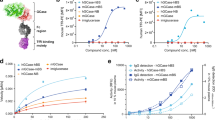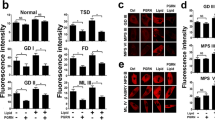Abstract.
We have proposed a chemical chaperone therapy for lysosomal diseases, based on a paradoxical phenomenon that an exogenous competitive inhibitor of low molecular weight stabilizes the target mutant molecule and restores its catalytic activity as a molecular chaperone intracellularly. After Fabry disease experiments, we investigated a new synthetic chaperone compound N-octyl-4-epi-β-valienamine (NOEV) in a GM1-gangliosidosis model mice. Orally administered NOEV entered the brain through the blood-brain barrier, enhanced β-galactosidase activity, reduced the substrate storage, and clinically improved neurological deterioration. We hope that chemical chaperone therapy will prove useful for some patients with GM1-gangliosidosis and potentially other lysosomal storage diseases with central nervous system involvement.
Similar content being viewed by others
Author information
Authors and Affiliations
Corresponding author
Additional information
Received 10 October 2007; received after revision 31 October 2007; accepted 6 November 2007
Rights and permissions
About this article
Cite this article
Suzuki, Y. Chemical chaperone therapy for GM1-gangliosidosis. Cell. Mol. Life Sci. 65, 351–353 (2008). https://doi.org/10.1007/s00018-008-7470-2
Published:
Issue Date:
DOI: https://doi.org/10.1007/s00018-008-7470-2




